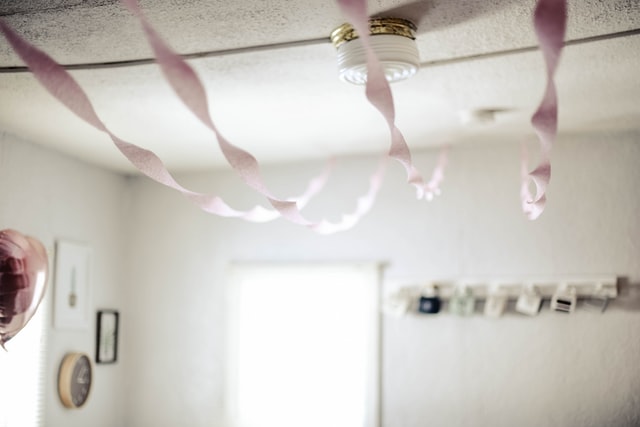A grease stain on the Ceiling above the stove, for example, may go unnoticed since it doesn’t urgently require your attention.
In the kitchen, the Ceiling is often overlooked, but it’s a breeding ground for aromas, smoke, humidity, and germs, much like the stovetop and counters, and they can all build up there as well.
Table of Contents
How To Clean Grease Off Kitchen Ceiling?
Grease accumulates on kitchen appliances, worktops, and walls surrounding the stove and on the ceilings, where it must be removed as part of your regular cleaning practice. For the most part, ceilings are painted in a flat finish, which hides defects effectively but requires delicate washing to remove stains and water spots.
Remove Grease from the kitchen ceiling as soon as possible to avoid permanent stains or damage from more vigorous cleaning; however, hold off on bringing out the ladder and rags just yet.
- Ensure your floors are protected from the inevitable leaking that occurs when you clean overhead by covering them with a tarp or garbage bags.
- Fill a bucket with a vinegar-to-hot-water solution of 2 tablespoons vinegar to 1 quart. It’s a good idea to use vinegar as a cleaner, but overdoing it might harm flat paint.
- Dishwasher soap, not the sort you use in the dishwasher, should be added to the water. Soap designed to Remove Grease from dishes is an excellent addition to your degreasing solution since it is powerful yet delicate enough not to harm your freshly painted Ceiling.
- Pour cleaning solution over the sponge mop and wring it out.
- Gently press the mop against the Ceiling as you move over the oily region. A ladder is necessary if your ceilings are high or vaulted, even with a long mop handle.
- The mop should often be dipped into the bucket to remove oil from the mop and refill the cleaning solution. Squeezing off the excess water is a must every time.
- Make sure you get all of the oil out of each component before moving on to the next one.Clean hot water can be used to rinse the Ceiling once you’ve finished washing it.
- After rinsing the mop in hot water, wring off any remaining moisture.
- To remove soap or vinegar residue from a freshly cleaned ceiling, use a moist clean mop with a back and forth motion. Repeat this process until the Ceiling is slightly wet and there is no soap residue.
The Equipment and Supplies You’ll Need:
- Trash bags
- Tarps
- A mop
- Bucket
- Vinegar
- Dish soap
- A ladder
The splatter of Grease on the Ceiling Over the Stove
It’s probably time to get your hands dirty if you see a grease spot on the Ceiling above your cooktop. Grease splatters can reach the Ceiling, where you may not see them until it’s too late.
It’s essential to keep an eye out for them as you cook. Smoke rising from the stove and oven and the dampness common to kitchens may both harm the Ceiling.To clean our ceilings as frequently as we wash other surfaces, we must deal with more practical issues.
While different paint kinds are resistant to stains, ceiling paint can be readily ruined by water or abrasive cleaning methods. To assess whether there’s any damage, clean a tiny patch of the Ceiling with whatever cleaner you’re using. A comprehensive cleaning can be done if necessary.
Cleaning Product Types That Work Best
Liquid cleaning solutions might leak from the Ceiling as you work, resulting in water damage. It’s better to clean a tiny area at a time rather than cover the entire roof in cleaner all at once to avoid this. Make sure your kitchen surfaces are protected by laying down tarps if your cleaning creates significant drips. Your kitchen should be clean and free of grease and filth if you’re the proud owner of a home.
Use a cloth or sponge to clean each piece of the Ceiling if you can reach it while standing on a chair. Sponge mop cleaning is a time-saving option. Make sure to thoroughly wring out the mop head before cleaning the Ceiling to avoid dripping.
To prevent transferring other household filth to the Ceiling, start with a clean mop head. Use a rubber band to attach a soft cloth to the mopping if you do not have a sponge mop.
What is the best cleaning product to use?
The paint on the Ceiling and the tiles on the Ceiling are both vulnerable to water damage. It’s usually acceptable to use a multipurpose kitchen cleaner but test it first in an inconspicuous location.
If you wish to make your own cleaner, use 2 teaspoons either white vinegar or ammonia and 1 quart of warm water.With just a few drops of dish soap and a few gallons of warm water, you can clean sensitive surfaces like a ceiling that doesn’t have many layers of shiny paint.
As an alternative, you may use a microfiber cloth to wipe the Ceiling with lemon juice after spritzing it gently. Salt can be added to the scouring process to remove stubborn stains. If grease stains are still visible after a deep clean, a new ceiling may be required. If this is the case, use a primer/sealant like Kilz to protect the surface from further moisture or grease damage.
